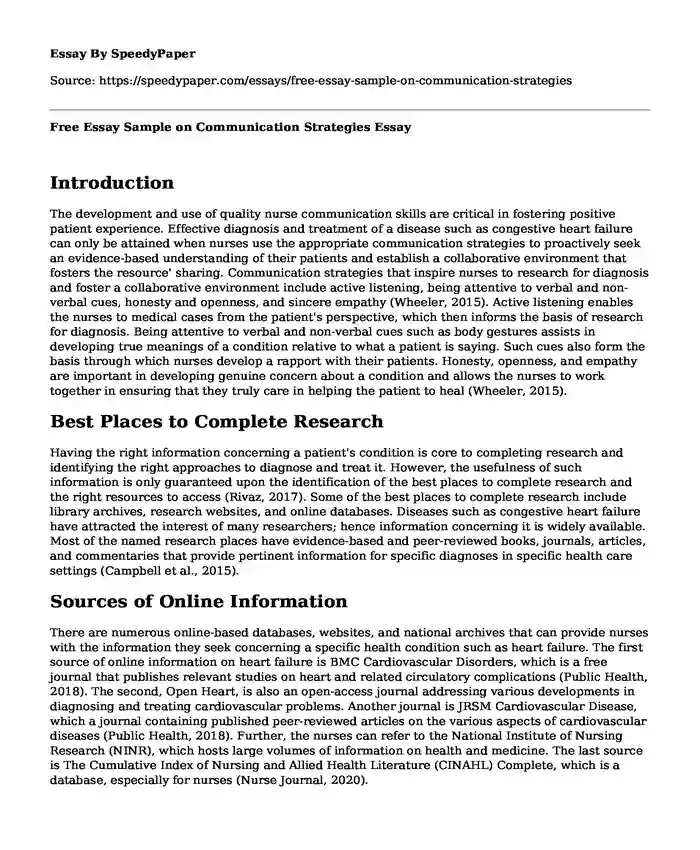
| Type of paper: | Essay |
| Categories: | Strategy Communication Nursing |
| Pages: | 3 |
| Wordcount: | 694 words |
Introduction
The development and use of quality nurse communication skills are critical in fostering positive patient experience. Effective diagnosis and treatment of a disease such as congestive heart failure can only be attained when nurses use the appropriate communication strategies to proactively seek an evidence-based understanding of their patients and establish a collaborative environment that fosters the resource' sharing. Communication strategies that inspire nurses to research for diagnosis and foster a collaborative environment include active listening, being attentive to verbal and non-verbal cues, honesty and openness, and sincere empathy (Wheeler, 2015). Active listening enables the nurses to medical cases from the patient's perspective, which then informs the basis of research for diagnosis. Being attentive to verbal and non-verbal cues such as body gestures assists in developing true meanings of a condition relative to what a patient is saying. Such cues also form the basis through which nurses develop a rapport with their patients. Honesty, openness, and empathy are important in developing genuine concern about a condition and allows the nurses to work together in ensuring that they truly care in helping the patient to heal (Wheeler, 2015).
Best Places to Complete Research
Having the right information concerning a patient's condition is core to completing research and identifying the right approaches to diagnose and treat it. However, the usefulness of such information is only guaranteed upon the identification of the best places to complete research and the right resources to access (Rivaz, 2017). Some of the best places to complete research include library archives, research websites, and online databases. Diseases such as congestive heart failure have attracted the interest of many researchers; hence information concerning it is widely available. Most of the named research places have evidence-based and peer-reviewed books, journals, articles, and commentaries that provide pertinent information for specific diagnoses in specific health care settings (Campbell et al., 2015).
Sources of Online Information
There are numerous online-based databases, websites, and national archives that can provide nurses with the information they seek concerning a specific health condition such as heart failure. The first source of online information on heart failure is BMC Cardiovascular Disorders, which is a free journal that publishes relevant studies on heart and related circulatory complications (Public Health, 2018). The second, Open Heart, is also an open-access journal addressing various developments in diagnosing and treating cardiovascular problems. Another journal is JRSM Cardiovascular Disease, which a journal containing published peer-reviewed articles on the various aspects of cardiovascular diseases (Public Health, 2018). Further, the nurses can refer to the National Institute of Nursing Research (NINR), which hosts large volumes of information on health and medicine. The last source is The Cumulative Index of Nursing and Allied Health Literature (CINAHL) Complete, which is a database, especially for nurses (Nurse Journal, 2020).
Conclusion
The selected sources should provide the best evidence for congestive heart failure since there are various factors that confirm their reliability, validity, and trustworthiness. First, most of the articles that they provide are peer-reviewed since they are written by experts and reviewed by others to ensure that they are scientifically valid and have reasonable conclusions (Nurse Journal, 2020). Second, they claim that the information that they publish are for academic and experts rather than the general public making it appeal to the interest of the nurses, specifically in their interest to find appropriate diagnoses and treatment for heart failure. Finally, the sources are current and generally professional, making the information readable and applicable to the contemporary context.
References
Campbell, J. M., Umapathysivam, K., Xue, Y., & Lockwood, C. (2015). Evidence-based practice point-of-care resources: A quantitative evaluation of quality, rigor, and content. Worldviews on Evidence-Based Nursing, 12(6), 313-327.
https://doi.org/10.1111/wvn.12114
Nurse Journal. (2020, July 2). Online research guide for nursing students. NurseJournal.
https://nursejournal.org/articles/online-research/
Public Health. (2018, November 28). Heart disease resources. PublicHealth.org.
https://www.publichealth.org/resources/heart-disease/
Rivaz, M. (2017). Adequate resources as essential component in the nursing practice environment: A qualitative study. Journal of Clinical and Diagnostic Research.
https://doi.org/10.7860/jcdr/2017/25349.9986
Wheeler, K. K. (2015). Effective handoff communication. Nursing Critical Care, 10(6), 13-15.
https://doi.org/10.1097/01.ccn.0000472849.85679.
Cite this page
Free Essay Sample on Communication Strategies. (2023, Nov 26). Retrieved from https://speedypaper.net/essays/free-essay-sample-on-communication-strategies
Request Removal
If you are the original author of this essay and no longer wish to have it published on the SpeedyPaper website, please click below to request its removal:
- Essay Sample on Strategic Management and Knowledge Management Theory and Research
- Free Paper Sample: Interview with a Manager
- Free Essay on How Communication Affects the Workplace
- Free Essay on Retaining a Long-time Customer
- Inadequate Supplier Measurement System in Firms - Essay Sample
- Essay Example on Impact of Technology and Social Media on People
- Essay Example: Problem Identification Capstone Reflection
Popular categories




